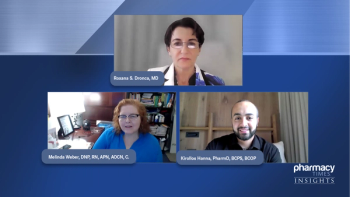
Advice For Pharmacists Exploring Prescription Discount Programs
Experts provide advice for community pharmacists wanting to explore options, such as Prescription Discount Programs, to help improve their patients’ outcomes.
Episodes in this series

Suzanne Soliman, PharmD, BCMAS: In terms of advice you have for community pharmacists offering this, what kind of advice do you have for them and for their patients?
Lisa King, RPh: I think, honestly, the patient loyalty and the service provided to the patient—you can’t put a dollar value on that. You may not be getting quite the amount of money that you got through their co-pay, but it provides that patient loyalty. The patient knows you are looking out for their best interests. They are loyal to your store, they purchase other things while they are there, but not only that, they keep coming back to you as their pharmacist. You are able to have that great rapport with the patient. I think, for me, as a pharmacist and most pharmacists, that is what it is really all about. It is that patient connection, that we are wanting to do the best job for the patient. And one great way to do it is through the prescription discount programs [PDPs].
Suzanne Soliman, PharmD, BCMAS: I always tell pharmacists, as well, that the prescription discount cards are here. We have to embrace them, begin to figure out how to use them, and see how they can best benefit the pharmacy or patients. What recommendations do you have for pharmacists who are hesitant to use them or are nervous about using them? How can they ease into using these cards?
Lisa King, RPh:I think finding a few cards you can offer to your patients and establishing that rapport and that loyalty with the patient is important. You do not have to take all of them. There are definitely some that are better than others, so when the patient comes in with that stack, you can say, “This is the one I recommend.” Really, we need to know the ins and outs, know which cards are your go-to cards. I know I can use these 3 cards, and they are going to provide the best prices for my patients. Just get to know the cards. Like you said, it is something that is here to stay, and the reason many pharmacists have to take them now, is because the pharmacy down the street is taking it. They do as well in order to stay competitive. It is an important thing to continue doing for patients.
Suzanne Soliman, PharmD, BCMAS: Definitely; if the pharmacy down the street is taking them, you do not want to lose your patient or their business because of that. In terms of patients who have jobs, I know we touched on that a little bit, in terms of insurance co-pays and things like that, but I think that is a group that does not think about this because the person is working, they have a job, and they have insurance. Do these PDPs work for all of them as well? Does that matter if they’re employed?
Lisa King, RPh:Yes, absolutely. I can think of one particular provider where the co-pay would always be in the $15 to $20 range, for even generic medications. You could get the price down by almost half using a prescription discount program. For people who are using multiple medications monthly, that can be a big savings over time.
Suzanne Soliman, PharmD, BCMAS: In terms of the manufacturers’ coupons, I know they encourage the use of brand name drugs, and they help you to get the brand names to go through. Do these discount cards, which are a little different, do they work on generic medications and not just brands?
Lisa King, RPh:Yes, these do work on generic medications. Right now, at the pharmacy where I am working [Nexus Patient Services], we work with patients who have a specific disease state. Many of the medications they are on are only brand name medications, so the discount cards do not work as well in those cases. They often work better with generics. That is very big, that we use a lot of the co-pay cards with our patients.
Suzanne Soliman, PharmD, BCMAS: Definitely.
Lisa King, RPh: They come from the manufacturer.
Suzanne Soliman, PharmD, BCMAS: It is 2 different sets, almost. I think a lot of times people just want to know the differences; patients and pharmacists as well want to know, so that is very helpful. Are there any last minute thoughts you have, Lisa, on this topic that we have not covered?
Lisa King, RPh:I have to say I have loved using prescription discount programs. I love saving money. I am a coupon queen, so I want my patients to save money as well. I would do whatever it takes to lower that cost for patients. I do not like seeing anybody, including myself, paying more than they have to for anything. I highly encourage it. We had very loyal patients where I was at last, in my retail setting. I highly encourage pharmacists to use the card. I think it is a great service to patients.
Suzanne Soliman, PharmD, BCMAS: I agree. I think, where you can save money, save it, and spend it somewhere else. Go on a trip or do something else with it. Donate it—do anything else. I agree. Thank you so much for talking to me today about this. To our viewing audience, we hope you found this Pharmacy Times® Insights discussion very valuable and to be rich and informative. Thank you.
Transcript edited for clarity.
Newsletter
Stay informed on drug updates, treatment guidelines, and pharmacy practice trends—subscribe to Pharmacy Times for weekly clinical insights.







































































































































































































